Are you a Quiet Speculation member?
If not, now is a perfect time to join up! Our powerful tools, breaking-news analysis, and exclusive Discord channel will make sure you stay up to date and ahead of the curve.
It's time for our second metagame update since launching our site! Although there haven't been any major Modern Grand Prix or SCG Open events since the last article, the format has seen dozens of regional and local events in that time (not to mention all those juicy MTGO dailies). As with all metagame updates, data comes from our Top Decks page, where we aggregate Modern events from across the internet into one place. We then use a variety of statistical methods to tier decks (Tier 1 and Tier 2), and generally describe the metagame. You can also see the updated metagame stats on our home page on the right navbar. For anyone wondering why Tasigur, the Golden Fang is showing up below, you'll have to wait until the Tier 2 deck section to see a surprising mover in the Modern scene.
Quick note about what is included in the dataset: for MTGO, we are looking at 35 dailies that took place between 3/1 and 4/1. This includes ones reported on the mothership and others recorded directly from the MTGO client. And remember MTGO dailies only include 4-0/3-1 lists, not the 2-2 or worse ones. For paper, we are looking at 115 events comprising almost 650 decks, all from across the world. Finally, although there were no "major" events in that range, we are still including SCG Open Baltimore in the analysis as a single "major event" representative.
[wp_ad_camp_1]
Top 10 Decks and Trends
To the numbers! Below is a snapshot of the top 10 decks from 3/1 to 4/1, broken down by overall deck prevalence and then by metagame share within each of the format subsets (i.e. paper, MTGO, and major paper event).
| Deck name | Overall rank (3/1 - 4/1) | Overall Metagame % | MTGO % | Paper % | Major Event Day 2 % |
|---|---|---|---|---|---|
| Abzan | 1 | 13.2% | 9.3% | 11.6% | 18.8% |
| UR Twin | 2 | 11.8% | 11.6% | 11.4% | 12.5% |
| Burn | 3 | 10.2% | 10.1% | 9.5% | 10.9% |
| Affinity | 4 | 7% | 7.8% | 10.2% | 3.1% |
| Infect | 5 | 6% | 2.6% | 5.9% | 9.4% |
| Jund | 6 | 4.2% | 2.2% | 4.1% | 6.3% |
| Abzan Liege | 7 | 3.1% | 2.8% | 3.6% | 3.1% |
| RG Tron | 8 | 3% | 2.3% | 3.6% | 3.1% |
| Merfolk | 9 | 2.9% | 4.3% | 4.2% | 0% |
| Amulet Bloom | 10 | 2.7% | 3.6% | 3% | 1.6% |
For anyone who has been following Modern events, there shouldn't be too many surprises here. Abzan, UR Twin, Burn, Affinity, and Infect have been the tier 1 decks in Modern since the Pro Tour, and that didn't change since our last update. It's interesting, however, to see the distributions of these decks across the different event types. For instance, Infect is a major paper player, but has less than 3% of the MTGO metagame. Affinity has been doing well in paper events and, to a lesser extent, MTGO, but had only about 3% of the SCG Open metagame.
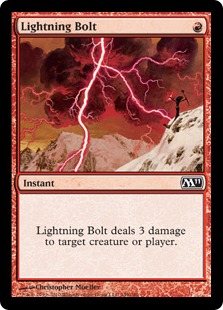 As for the decks under those top 5, they are mostly the same as in the previous update, with one big exception: Jund. Replacing Scapeshift on the list, Jund has rocketed up from 12th or so place in 2/16-3/16 to 6th as of 4/1. This is interesting but shouldn't come as that much of a surprise. Players like Reid Duke have been extolling Jund in this metagame for months, especially given the relative weakness of Path to Exile as compared to Lightning Bolt in a format with Affinity, Burn, and Infect.
As for the decks under those top 5, they are mostly the same as in the previous update, with one big exception: Jund. Replacing Scapeshift on the list, Jund has rocketed up from 12th or so place in 2/16-3/16 to 6th as of 4/1. This is interesting but shouldn't come as that much of a surprise. Players like Reid Duke have been extolling Jund in this metagame for months, especially given the relative weakness of Path to Exile as compared to Lightning Bolt in a format with Affinity, Burn, and Infect.
Just to get a sense of deck trends, here's a table that shows the top 10 decks in our last period (2/16 - 3/16), and compares it to the rankings from the present period (3/1 - 4/1):
| Deck name | Ranking (2/16-3/16) | Ranking (3/1-4/1) | Rank change | Meta% (2/16-3/16) | Meta% (3/1-4/1) | Meta% change |
|---|---|---|---|---|---|---|
| Abzan | 1 | 1 | +0 | 13.4% | 13.2% | -.2% |
| UR Twin | 2 | 2 | +0 | 12.3% | 11.8% | -.5% |
| Burn | 3 | 3 | +0 | 10.6% | 10.2% | -.4% |
| Affinity | 4 | 4 | +0 | 7.8% | 7% | -.8% |
| Infect | 5 | 5 | +0 | 7% | 6% | -1% |
| Abzan Liege | 6 | 7 | +1 | 3.3% | 3.1% | -.2% |
| Merfolk | 7 | 9 | -2 | 3.3% | 2.9% | -.4% |
| RG Tron | 8 | 8 | +0 | 2.9% | 3% | +.4% |
| Amulet Bloom | 9 | 10 | -1 | 2.7% | 2.7% | +0% |
| Scapeshift | 10 | 11 | -1 | 2.3% | 1.8% | -.5% |
| Jund | 11 | 6 | +5 | 2.3% | 4.2% | +1.9% |
This is a relatively stable metagame. With the exception of Jund, which enjoyed an almost 2% point increase in the period, most of the decks are about the same. Infect has fallen off the most with a 1% point dip, and Merfolk fell the most with respect to its ranking. But overall, the metagame didn't change much between our two periods. This suggests any testing or results you know of that applied back in 2/16 - 3/16 will still likely apply today; the metagames are, after all, still very similar.
Tier 1 and Tier 2 Decks
It's important to know the top 10 decks in the format for descriptive reasons. Those decks can give you an overall sense as to what strategies are represented in Modern, and some guidance on how you can choose/build a deck. But we can also use deck prevalence to suggest "tiers" of decks in the format. We do this through a variety of statistical tools, testing deck prevalences to see if they are within expected variance or truly above average. Does prevalence always equal performance? Absolutely not! Sometimes the best decks are underplayed. But when you are going to a tournament and want decks that have consistent results, the tiers can be very useful for illustrating that. You can get more info about this on our Top Decks page.
Tier 1 decks represent the most-played and most-common decks in the metagame. Again, they are not necessarily the best decks in the format, but they have so many results that you can safely expect to both succeed with them and to play against them in events. The table below shows the current tier 1 decks in Modern, as per our formulas on the site.
| Deck name | Overall Metagame % | MTGO % | Paper % | Major Event Day 2 % |
|---|---|---|---|---|
| Abzan | 13.2% | 9.3% | 11.6% | 18.8% |
| UR Twin | 11.8% | 11.6% | 11.4% | 12.5% |
| Burn | 10.2% | 10.1% | 9.5% | 10.9% |
| Affinity | 7% | 7.8% | 10.2% | 3.1% |
| Infect | 6% | 2.6% | 5.9% | 9.4% |
Not a lot of surprises here. As a whole, the tier 1 decks make up about 48% of the format, which is a slight but probably insignificant decrease from their 2/16-3/16 share of 51%. This tier 1 reflects the overall impression that a lot of players have about Modern. Abzan is still the most-played deck; Twin is still very strong, despite Abzan's prevalence; the other top decks are all fast, linear, aggressive decks that have game against Abzan. Ever since August 2014, Modern has been a format dominated by the big three of BGx Midrange (now Abzan), Twin, and Burn. Today is no exception.
To anyone who has been playing Modern for even just a few months, none of this should be too surprising, except perhaps the continued relevance of Infect. Otherwise, those other decks have been around forever (especially Affinity!). Prepare for your Modern events accordingly.
Tier 2, however, is much more interesting. These decks might not be the most-played in the format, but they have enough results that you can reasonably expect to face them in an event. They also have enough results that they generally make decent choices, although not quite as safe as the tier 1 representatives. Tier 1 decks are often pretty predictable or boring. But as we see here, tier 2 decks are anything but.
| Deck name | Overall Metagame % | MTGO % | Paper % | Major Event Day 2 % |
|---|---|---|---|---|
| Jund | 4.2% | 2.2% | 4.1% | 6.3% |
| Abzan Liege | 3.1% | 2.8% | 3.6% | 3.1% |
| RG Tron | 3% | 2.3% | 3.6% | 3.1% |
| Merfolk | 2.9% | 4.3% | 4.2% | 0% |
| Amulet Bloom | 2.7% | 3.6% | 3% | 1.6% |
| UWR Control | 1.9% | 1.7% | 2.3% | 1.6% |
| Grixis Delver | 1.9% | 2.7% | 1.3% | 1.6% |
| Scapeshift | 1.8% | 2.1% | 1.9% | 1.6% |
| Living End | 1.8% | 1.4% | 2.3% | 1.6% |
| Bogles | 1.8% | 1.4% | 1% | 3.1% |
| Blue/Temur Moon | 1.5% | .2% | 1.1% | 3.1% |
| Temur Twin | 1% | .3% | 1.3% | 1.6% |
Now that's what I call a Modern format! This is one of the more diverse tier 2s I have seen in a while. We have some more aggressive BGx hybrids (Jund and Abzan Liege) for those dissatisfied with Abzan's more passive pace. We have minimally interactive, "unfair" combo (Amulet Bloom) along with combo control (Scapeshift). Speaking of which, UWR Control, Blue Moon, and Scapeshift are those more traditional draw-go style control decks that people (myself included) have been missing from Modern. They might not be the best decks in the format, but these numbers suggest they are more alive than people acknowledge. Tier 2 also has some iconic Modern decks like Living End and RG Tron, as well as Merfolk and Bogles in case you still thought that you needed Tarmogoyf to play aggro in Modern.
But the real winner in our tier 2 is Grixis Delver.
Following the landmark bannings of Treasure Cruise and Dig Through Time, it looked like Modern had seen the end of Delver-based decks for a while. Although there are reasons to hate Delver, there are also reasons to want the deck in the format: it polices combo decks, it's a competitive and reasonably priced strategy, and it's a true tempo deck that is often absent from Modern. Grixis Delver proved that Delver still has legs wings, even in a field saturated with Abzan. Adding Terminate, Inquisition of Kozilek, Murderous Cut, and/or Tasigur (along with other black staples), Grixis Delver has found a new home in this metagame. It has the manpower to fight Abzan and the interaction to stop combo decks. Although it has a long way to go before tier 1 status, its presence is a great development for Modern diversity and for many Modern players.
Metagame Predictions
My metagame predictions from the past article mostly came true. The Big Three are still the format kings, although that was about as safe a bet as having Kentucky go to the Final Four in your March Madness bracket. I could probably make this bet every article until July and be right, so in the interest of fairness, I'll try not to make it unless the metagame is actually that boring.
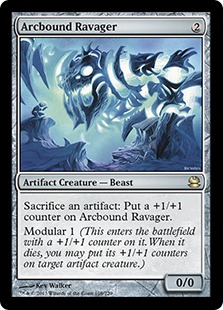 The Affinity and Merfolk predictions were also good ones, although their relative absence at SCG Baltimore affected their overall metagame share. But looking just at MTGO and paper, both decks saw sizable increases. Affinity went from 6.4% to 7.8% on MTGO, and from 8.7% to 10.2% in paper. Merfolk saw more modest increases, with 3.4% to 4.3% in MTGO and 3.7% to 4.2% in paper. But overall, this was another spot-on prediction. You want to play proactive strategies in Modern, and Affinity/Merfolk are fast, proactive decks with totally painless manabases. This makes them good choices both for the overall format demands, and also with so much Burn to go up against.
The Affinity and Merfolk predictions were also good ones, although their relative absence at SCG Baltimore affected their overall metagame share. But looking just at MTGO and paper, both decks saw sizable increases. Affinity went from 6.4% to 7.8% on MTGO, and from 8.7% to 10.2% in paper. Merfolk saw more modest increases, with 3.4% to 4.3% in MTGO and 3.7% to 4.2% in paper. But overall, this was another spot-on prediction. You want to play proactive strategies in Modern, and Affinity/Merfolk are fast, proactive decks with totally painless manabases. This makes them good choices both for the overall format demands, and also with so much Burn to go up against.
As for Esper Midrange, although it did not experience the same success as Grixis Delver, it has definitely risen up to a new level of viability. It's at about 1.8% of the MTGO metagame, but still lagging behind at < 1% for paper. Some small misses here, but I'm still calling this a 3 for 3. Too bad my NCAA bracket wasn't that good.
Looking ahead to our next update in the middle of April, here are three more predictions to look forward to.
1. Jund is on the rise!
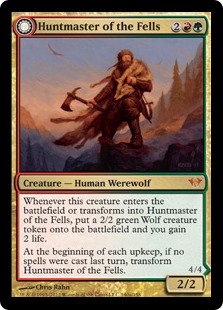 I talked about this earlier in the article, but want to broaden it to a bigger metagame trend. Jund has a lot of tools that make it strong in this metagame. Huntmaster of the Fells is very powerful in the BGx mirror, stalls aggro decks, and generally breaks open staring contests. Terminate is one of the big reasons Grixis Delver is doing so well right now, and the ability to play it as an unconditional removal spell over Path is huge in this metagame. Jund also has a less painful manabase than Abzan, courtesy of Blackcleave Cliffs, which is important against Burn. And of course, Bolt is a lot stronger in this format than people were giving it credit for during the PT. All of these factors combine to make Jund a strong deck choice, and I expect it to maintain its metagame share in the next few weeks, even increasing it by up to 1%.
I talked about this earlier in the article, but want to broaden it to a bigger metagame trend. Jund has a lot of tools that make it strong in this metagame. Huntmaster of the Fells is very powerful in the BGx mirror, stalls aggro decks, and generally breaks open staring contests. Terminate is one of the big reasons Grixis Delver is doing so well right now, and the ability to play it as an unconditional removal spell over Path is huge in this metagame. Jund also has a less painful manabase than Abzan, courtesy of Blackcleave Cliffs, which is important against Burn. And of course, Bolt is a lot stronger in this format than people were giving it credit for during the PT. All of these factors combine to make Jund a strong deck choice, and I expect it to maintain its metagame share in the next few weeks, even increasing it by up to 1%.
2. Affinity will replace Burn as the format's top aggro deck
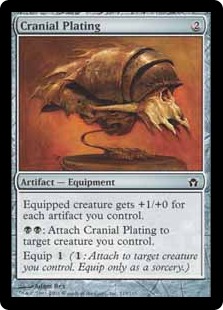 Bold prediction alert! On the one hand, Affinity is never a deck you want to bet against; this deck is probably the oldest competitive Modern deck that is most similar to its earliest Modern forms. But it's also a deck that has seen ups and downs, going through dry spells when people pay more attention to it. One of the key cards in this equation is Stony SIlence, a card that is extremely challenging for Affinity to win through if played by a proactive deck. Know what decks don't run Silence? Twin, Infect, Grixis Delver, Jund, and a bunch of other hot decks right now. Know what those decks are running? Lifegain and anti-Burn tech in spades. Between the rise of decks that don't use Silence or have strong anti-Affinity cards, and their focus on lifegain strategies that target Burn, Affinity should continue to rise up until it passes Burn at the top tables. Even if some toolboxy Collected Company style deck emerges, this will almost certainly be worse for Burn (hello, Kitchen Finks) than it will be for Affinity. A corollary to this prediction is that Burn will keep falling. And speaking of Company...
Bold prediction alert! On the one hand, Affinity is never a deck you want to bet against; this deck is probably the oldest competitive Modern deck that is most similar to its earliest Modern forms. But it's also a deck that has seen ups and downs, going through dry spells when people pay more attention to it. One of the key cards in this equation is Stony SIlence, a card that is extremely challenging for Affinity to win through if played by a proactive deck. Know what decks don't run Silence? Twin, Infect, Grixis Delver, Jund, and a bunch of other hot decks right now. Know what those decks are running? Lifegain and anti-Burn tech in spades. Between the rise of decks that don't use Silence or have strong anti-Affinity cards, and their focus on lifegain strategies that target Burn, Affinity should continue to rise up until it passes Burn at the top tables. Even if some toolboxy Collected Company style deck emerges, this will almost certainly be worse for Burn (hello, Kitchen Finks) than it will be for Affinity. A corollary to this prediction is that Burn will keep falling. And speaking of Company...
3. Collected Company will remain homeless
 We've seen a number of attempts at an optimized Collected Company deck in the past week. This has included a Naya Zoo deck, a few "Podless Pod" brews with Anafenza, Kin-Tree Spirit, Elves, Mono G Stompy, and a number of other decks. A week is not long enough to optimize a list for this card; I want to extend that to say we will need at least another 1-2 months to figure out where Company needs to go in Modern. There are two reasons for this. First, from a pure scheduling perspective, there are no major Modern events until June. In the absence of those big proving grounds, it will be hard to make a case for any single CC list over another. Second, just looking at preliminary results from the last week, we are seeing so many different lists that it is unlikely anyone will reach a consensus yet. Sometimes this isn't needed; Esper Mentor Midrange adopted Monastery Mentor and everyone sort of followed along, agreeing that was the best place for the card. We aren't seeing that with CC yet, and I don't expect to see it for a while.
We've seen a number of attempts at an optimized Collected Company deck in the past week. This has included a Naya Zoo deck, a few "Podless Pod" brews with Anafenza, Kin-Tree Spirit, Elves, Mono G Stompy, and a number of other decks. A week is not long enough to optimize a list for this card; I want to extend that to say we will need at least another 1-2 months to figure out where Company needs to go in Modern. There are two reasons for this. First, from a pure scheduling perspective, there are no major Modern events until June. In the absence of those big proving grounds, it will be hard to make a case for any single CC list over another. Second, just looking at preliminary results from the last week, we are seeing so many different lists that it is unlikely anyone will reach a consensus yet. Sometimes this isn't needed; Esper Mentor Midrange adopted Monastery Mentor and everyone sort of followed along, agreeing that was the best place for the card. We aren't seeing that with CC yet, and I don't expect to see it for a while.
That's all for this most recent metagame update! We'll check back on these predictions and the overall format in a few weeks. Until then, don't forget to check out our Top Decks page, make some predictions of your own in the comments or community, and to incorporate all this exciting metagame data into your deckbuilding.


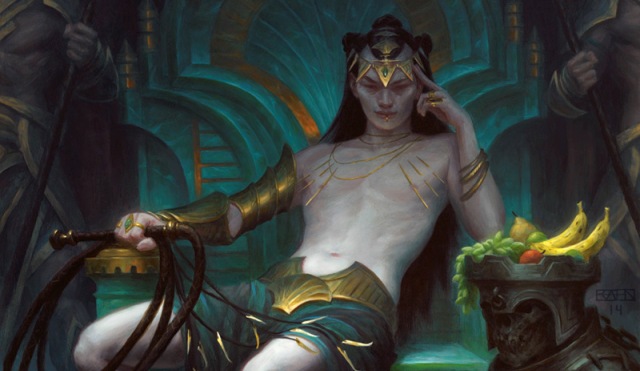

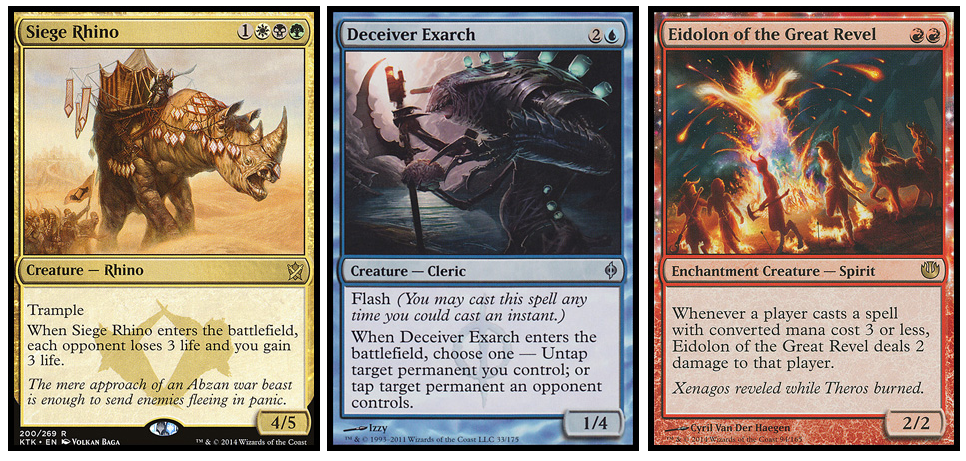
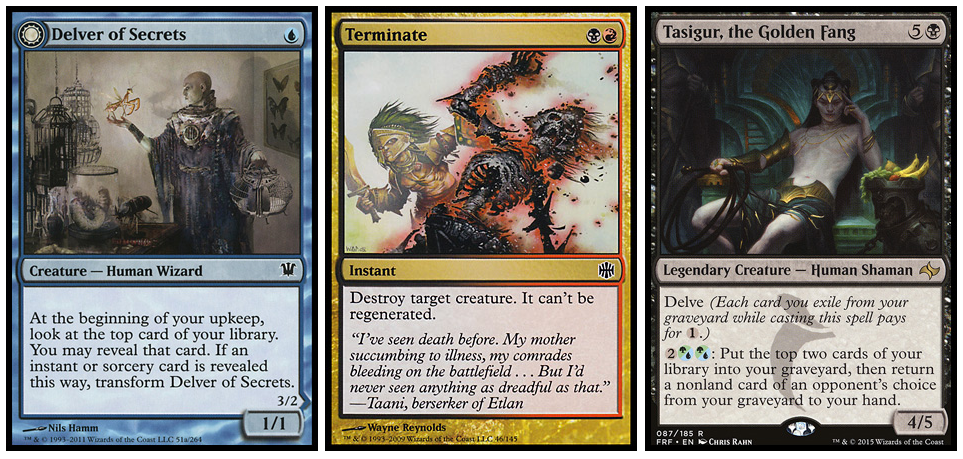


Excellent breakdown of the meta. Very informative, and I think your analysis/future predictions have some merit. I have a couple of observations/comments:
1) You mentioned Grixis Delver, but I think one thing that should see some coverage is the resurgence of UR Delver. At least on MTGO, some Delver players seem to have picked themselves up, retooled by swapping out the raw speed of Gitaxian Probe and Monastery Swiftspear for the value/tempo-based beef of Vendilion Clique and Grim Lavamancer, and it’s working. At least, MTGTop8 has a bunch of results to that effect. Any thoughts?
2) I think that you’re right in that Collected Company doesn’t necessarily fit neatly into any of the major archetypes currently seeing play in Modern – which is why I think one will arise in order to accomodate it. My prediction is that a Naya “Big Zoo” style of deck is the one that will become Collected Company’s home. By that, I mean one that focuses on mana dorks such as Noble Hierarch and Birds of Paradise in the 1-drop slot (of course, you’ll still have your Nacatls), and then leans heavily on 3-drops like Woolly Thoctar (very relevant in this world of Tasigurs and Siege Rhinos), Loxodon Smiters, and Knights of the Reliquary. Any thoughts on that front?
1) UR Delver has increased both its paper and MTGO shares in the last month. Unfortunately, it doesn’t look like that increase is nearly as high as Grixis Delver’s. One of the big issues with MTGTop8, and a number of other sites like it, is that they don’t include 3-1 finishes. It’s just 4-0 stuff. So although UR Delver might have some nice finishes there, those aren’t necessarily translating to 3-1 wins. Ideally, we would have a dataset that got every deck including the 2-2 or worse performances, but it’s just too labor intensive. And unfortunately for UR Delver, the more we add events, the less Delver shows up. The big issue with UR Delver is that without TC/DTT, it can’t fight Abzan effectively. Tasigur and Terminate fix that to an extent, which is a big reasons I think Grixis Delver is seeing so much success
2) I think the Big Zoo prediction is a good one. Zoo is a deck that is always doing okay in Modern (since Nacatl was unbanned, at least), so anything that can push one of its many subtypes will be welcome. It’s really hard for decks to recover from a turn 3-4 Company into Finks/Smiter/Goyf/etc. The issue with combo-based CC decks, built with or without Congregation at Dawn, is that they can have some really underwhelming flips. This gets you bodies on the board, but not a lot of value. CC is going to excel in a deck where your average flip puts at least 5 power into play. So if we do see a “Podless Pod” style deck emerge with CC, it needs to be less toolboxy and more like the Value Pod style lists we saw, that favor an aggressive gameplan to a toolbox one.
Glad you enjoyed the article! I’m excited to see where CC ends up as the format keeps developing.
Grixis Delver feels like a really solid deck to me. Every match up feels at least somewhat winnable, save maybe burn. If a pro would pick it up and tune it a bit more, I’m sure we could see some great finishes out of the deck.
I’m with you on your prediction of an Affinity resurgence – I think the deck is extremely well-positioned at the moment, and I think its ability to weather even the worst hate speaks to how strong it really is. Stony Silence was printed more than three years ago, and yet Affinity has remained a tier one strategy ever since! I think that tells you everything you need to know about how rock solid the deck is.